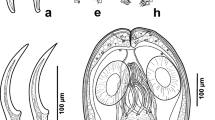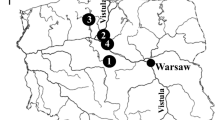Abstract
Adult crustaceans of the genus Artemia (brine shrimps) are intermediate hosts in the life cycle of cestode species parasitic in aquatic birds as their definitive hosts. However, there are no data on the role of larval and juvenile brine shrimps in the transmission of avian helminth parasites. In order to examine the possible role of early developmental stages (nauplii, metanauplii and juveniles) of Artemia for the circulation of avian cestodes, the natural cestode infection in the population of Artemia parthenogenetica from La Mata Lagoon, Mediterranean coast of Spain, was studied. Metacestodes (cysticercoids) of four cestode species were recorded in adult brine shrimps: Flamingolepis liguloides and Flamingolepis flamingo (hymenolepidids parasitic in flamingos), Confluaria podicipina (a hymenolepidid species parasitic in grebes) and Eurycestus avoceti (a dilepidid species parasitic in avocets, stilts, plovers and, to a lesser extent, in flamingos). No cysticercoids were found in nauplii. Two species, F. liguloides and F. flamingo, were found in metanauplii and juvenile brine shrimps. Only 36.3% of the cysticercoids of F. liguloides occurred in adult brine shrimps; the remaining 63.7% were parasitic in metanauplii (39.6%) and juveniles (24.1%). Similarly, the metacestodes of F. flamingo were also distributed among various age groups: in adults (44.4% of cysticercoids), juveniles (27.8%) and metanauplii (27.8%). These results indicate that the early developmental stages of Artemia have an important role for the circulation of certain parasite species. No cysticercoids of C. podicipina and E. avoceti were recorded in larval and juvenile brine shrimps. The selective infestation of larval brine shrimps with flamingo parasites is probably associated with the feeding behaviour of definitive hosts, which are filtering predators; in contrast, grebes and waders pick brine shrimps individually one by one. The possible underlying mechanism for selective infestation of metanauplii and adults by certain cestode species is associated with the size of parasite eggs, allowing only cestode species with small eggs to be ingested by larval brine shrimps.






Similar content being viewed by others
References
Abatzopoulos TJ, Beardmore JA, Clegg JA, Sorgeloos P (2002) Artemia: basic and applied biology. Kluwer, Dordrecht
Amat F (1981) Zygogenetical and parthenogenetical Artemia in the Cadiz sea side salterns. Mar Ecol Prog Ser 13:291–293
Amat F, Hontoria F, Navarro JC, Gozalbo A, Varó I (1991a) Bioecología de Artemia (Crustacea, Branchiopoda) en la laguna de La Mata. Colección Técnica. Publicaciones del Instituto de Cultura "Juan Gil Albert", Alicante
Amat F, Illescas P, Fernández J (1991b) Brine shrimp Artemia from Spanish Mediterranean salterns parasitized by Flamingolepis liguloides (Cestoda, Hymenolepididae) cysticercoids. Vie Milieu 41:237–244
Amat F, Barata C, Hontoria F, Navarro JC, Varó I (1995) Biogeography of the genus Artemia (Crustacea, Branchiopoda, Anostraca) in Spain. Int J Salt Lake Res 3:175–190
Baer JG (1968) Eurycestus avoceti Clark 1954 (Cestode Cyclophyllidien) parasite de l´avocette en Camargue. Vie Milieu 19:189–198
Bush AO, Lafferty KD, Lotz JM, Shostak AW (1997) Parasitology meets ecology on its own terms: Margolis et al. revisited. J Parasitol 83:575–583
Caudell JN, Conover MR (2006) Energy content and digestibility of brine shrimp (Artemia franciscana) and other prey item of eared grebes (Podiceps nigricollis) on the Great Salt Lake, Utah. Biol Conserv 130:251–254
Chervy L (2002) The terminology of larval cestodes or metacestodes. Syst Parasitol 52:1–33
Dobbeleir J, Adams N, Bossuyt E, Bruggeman E, Sorgeloos P (1980) New aspects of the use of inert diets for high density culturing of brine shrimp. In: Persoone G, Sorgeloos P, Roels O, Jaspers E (eds) The brine shrimp Artemia, vol 3, Ecology, culturing, use in aquaculture. Universa Press, Wetteren, pp 165–174
Fellowes MDE, Travis JMJ (2000) Linking the coevolutionary and population dynamics of host–parasitoid interactions. Popul Ecol 42:195–203
Gabrion C, MacDonald G, Boy V (1982) Dynamique des populations larvaires du cestode Flamingolepis liguloides dans une population d´Artemia en Camargue. Acta Oecol 3(2):273–293
Gelabert R (2001) Artemia bioencapsulation: I. Effect of particle sizes on the filtering behavior of Artemia franciscana. J Crustac Biol 21:435–442
Georgiev BB, Sánchez MI, Green AJ, Nikolov PN, Vasileva GV, Mavrodieva RS (2005) Cestodes from Artemia parthenogenetica (Crustacea, Branchiopoda) in the Odiel marshes, Spain: a systematic survey of cysticercoids. Acta Parasitol 50:105–117
Georgiev BB, Sánchez MI, Vasileva GP, Nikolov PN, Green AJ (2007) Cestode parasitism in invasive and native brine shrimps (Artemia sp.) as a possible factor promoting the rapid invasion of A. franciscana in the Mediterranean region. Parasitol Res 101:1647–1655
Jenkin PM (1957) The filter feeding and food of flamingos (Phoenicopteri). Phil Trans Roy Soc Lond B Biol Sci 250(674):401–493
Maksimova AP (1981) Morphology and life cycle of the cestode Confluaria podicipina (Cestoda: Hymenolepididae). Parazitologiya 15:325–331 (In Russian)
Miller RG (1991) Simultaneous statistical inference. Springer, Berlin
Mura G (1995) Cestode parasitism (Flamingolepis liguloides Gervais, 1847) Spassky & Spasskaja, 1954 in an Artemia population from south-western Sardinia. Int J Salt Lake Res 3:191–200
Peterson RO, Page RE (1988) The rise and fall of Isle Royale wolves, 1975–1986. J Mammal 69:89–99
Peterson RO, Thomas NJ, Thurber JM, Vucetich JA, Waite TA (1998) Population limitation and the wolves of Isle Royale. J Mammal 79:828–841
Robert F, Gabrion C (1991) Cestodoses de l´avifaune camarguaise. Rôle d´Artemia (Crustacea, Anostraca) et stratégies de rencontre hôte–parasite. Ann Parasitol Hum Compa 66:226–235
Sánchez MI, Georgiev BB, Nikolov PN, Vasileva GP, Green AJ (2006) Red and transparent brine shrimps (Artemia parthenogenetica): a comparative study of their cestode infections. Parasitol Res 100:111–114
Sánchez MI, Georgiev BB, Green AJ (2007) Avian cestodes affect the behaviour of their intermediate host Artemia parthenogenetica: an experimental study. Behav Process 74:293–299
Sánchez MI, Thomas F, Perrot-Minnot MJ, Biron DG, Bertrand-Michel J, Missé D (2009a) Neurological and physiological disorders in Artemia harbouring manipulative cestodes. J Parasitol 95:20–24
Sánchez MI, Hortas F, Figuerola J, Green AJ (2009b) Sandpipers select red brine shrimps rich in both carotenoids and parasites. Ethology 115:196–200
Thiéry A, Robert F, Gabrion R (1990) Distribution des populations d´Artemia et de leur parasite Flamingolepis liguloides (Cestoda, Cyclophyllidea) dans les salins du littoral méditerranéen français. Can J Zool 68:2199–2204
Triantaphyllidis GV, Abatzopoulos TJ, Sorgeloos P (1998) Review of the biogeography of the genus Artemia (Crustacea, Anostraca). J Biogeogr 25:213–226
Varó I, Taylor AC, Navarro JC, Amat F (2000) Effect of parasitism on the respiration rates of adults of different Artemia strains from Spain. Parasitol Res 86:772–774
Vasileva GP, Redón S, Amat F, Nikolov PN, Sánchez MI, Lenormand T, Georgiev BB (2009) Records of cysticercoids of Fimbriarioides tadornae Maksimova, 1976 and Branchiopodataenia gvozdevi (Maksimova, 1988) (Cyclophyllidea, Hymenolepididae) from brine shrimps at the Mediterranean coasts of Spain and France, with a key to cestodes from Artemia spp. from the Western Mediterranean. Acta Parasitol 54:143–150
Acknowledgements
We would like to thank G. Medina for the help with field work. We are grateful to Concepción Torres, Director of the Paraje Natural de las lagunas de Torrevieja y La Mata, and the park keepers, who gave all facilities to work in the lagoon and provided the waterfowl census. This work was financed by the Spanish National Plan R & D (project CGL-2005- 02306/BOS) and by the EC-funded project WETLANET to the Institute of Biodiversity and Ecosystem Research, Bulgarian Academy of Sciences. The first author is supported by a Ph.D. grant (FPI) from the Spanish Ministry of Science and Innovation.
Author information
Authors and Affiliations
Corresponding author
Rights and permissions
About this article
Cite this article
Redón, S., Amat, F., Hontoria, F. et al. Participation of metanauplii and juvenile individuals of Artemia parthenogenetica (Branchiopoda) in the circulation of avian cestodes. Parasitol Res 108, 905–912 (2011). https://doi.org/10.1007/s00436-010-2132-3
Received:
Accepted:
Published:
Issue Date:
DOI: https://doi.org/10.1007/s00436-010-2132-3




